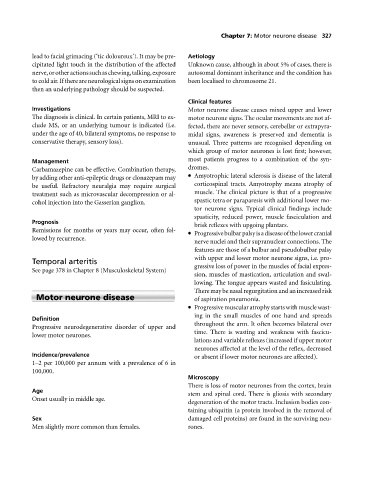Page 331 - Medicine and Surgery
P. 331
P1: FAW
BLUK007-07 BLUK007-Kendall May 25, 2005 18:18 Char Count= 0
Chapter 7: Motor neurone disease 327
lead to facial grimacing (‘tic doloureux’). It may be pre- Aetiology
cipitated light touch in the distribution of the affected Unknown cause, although in about 5% of cases, there is
nerve,orotheractionssuchaschewing,talking,exposure autosomal dominant inheritance and the condition has
to cold air. If there are neurological signs on examination been localised to chromosome 21.
then an underlying pathology should be suspected.
Clinical features
Investigations Motorneurone disease causes mixed upper and lower
The diagnosis is clinical. In certain patients, MRI to ex- motor neurone signs. The ocular movements are not af-
clude MS, or an underlying tumour is indicated (i.e. fected, there are never sensory, cerebellar or extrapyra-
under the age of 40, bilateral symptoms, no response to midal signs, awareness is preserved and dementia is
conservative therapy, sensory loss). unusual. Three patterns are recognised depending on
which group of motor neurones is lost first; however,
most patients progress to a combination of the syn-
Management
Carbamazepine can be effective. Combination therapy, dromes.
by adding other anti-epileptic drugs or clonazepam may Amyotrophic lateral sclerosis is disease of the lateral
be useful. Refractory neuralgia may require surgical corticospinal tracts. Amyotrophy means atrophy of
treatment such as microvascular decompression or al- muscle. The clinical picture is that of a progressive
cohol injection into the Gasserian ganglion. spastic tetra or paraparesis with additional lower mo-
torneurone signs. Typical clinical findings include
spasticity, reduced power, muscle fasciculation and
Prognosis
brisk reflexes with upgoing plantars.
Remissions for months or years may occur, often fol-
Progressivebulbarpalsyisadiseaseofthelowercranial
lowed by recurrence.
nerve nuclei and their supranuclear connections. The
features are those of a bulbar and pseudobulbar palsy
with upper and lower motor neurone signs, i.e. pro-
Temporal arteritis
gressive loss of power in the muscles of facial expres-
See page 378 in Chapter 8 (Musculoskeletal System)
sion, muscles of mastication, articulation and swal-
lowing. The tongue appears wasted and fasiculating.
Theremaybenasalregurgitationandanincreasedrisk
Motor neurone disease of aspiration pneumonia.
Progressive muscular atrophy starts with muscle wast-
ing in the small muscles of one hand and spreads
Definition
throughout the arm. It often becomes bilateral over
Progressive neurodegenerative disorder of upper and
time. There is wasting and weakness with fascicu-
lower motor neurones.
lations and variable reflexes (increased if upper motor
neurones affected at the level of the reflex, decreased
Incidence/prevalence or absent if lower motor neurones are affected).
1–2 per 100,000 per annum with a prevalence of 6 in
100,000.
Microscopy
There is loss of motor neurones from the cortex, brain
Age
stem and spinal cord. There is gliosis with secondary
Onset usually in middle age.
degeneration of the motor tracts. Inclusion bodies con-
taining ubiquitin (a protein involved in the removal of
Sex damaged cell proteins) are found in the surviving neu-
Men slightly more common than females. rones.

